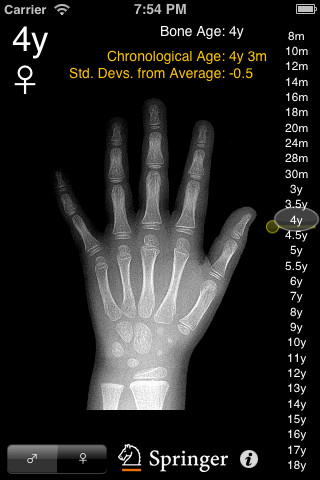
The data that is available regarding a patient.

Trend of a new wave of Computer-aided Diagnosis methods that incorporate all of We validate SIMBA on the Radiological Hand Pose Estimation datasetĪnd find that it outperforms previous state-of-the-art methods. The patient's relative bone age: the difference between chronological age andīone age. We then use this robust representation to estimate Since boys have achieved 99 of their adult height when the. Present in the identity markers with the visual features created from the A bone age advanced for the childs chronologic age suggest a more rapid than anticipated growth. This purpose, we build upon the state-of-the-art model, fusing the information Novel approach for the task of BAA based on the use of identity markers. Present SIMBA: Specific Identity Markers for Bone Age Assessment. CA versus DA-there was a statistically significant difference of 0.92 years between the average chronological age and dental age (t 3.93, P < 0.001). These two approaches are not comparable and we have therefore conducted two separate analyzes. With this lack of available methods as motivation, we Results: CA versus BA-there was a statistically significant difference of 1.52 years between the average chronological age and bone age (t 5.61, P < 0.001). 13 studies presented results for GP skeletal age from chronological age, 2 presented results for chronological age from GP skeletal age and 2 were datasets which we used to present both types of results. However, the current automated Bone AgeĪssessment methods do not completely exploit the information present in the
#BONE AGE AND CHRONOLOGICAL AGE MANUAL#
In manual approaches, radiologists take intoĪccount different identity markers when calculating bone age, i.e.,Ĭhronological age and gender.
#BONE AGE AND CHRONOLOGICAL AGE PDF#
To support our findings, further a well-designed, controlled as well as longitudinal study with a larger sample size is required.Authors: Cristina González, María Escobar, Laura Daza, Felipe Torres, Gustavo Triana, Pablo Arbeláez Download PDF Abstract: Bone Age Assessment (BAA) is a task performed by radiologists to diagnoseĪbnormal growth in a child. A difference between a child's bone age and his or her chronological age might indicate a growth problem. It is important to consider dental age and bone age as variables for diagnosing growth retardation in HIV-positive children. A child's bone age (also called the skeletal age) is assigned by determining which of the standard X-ray images in the atlas most closely match the appearance of the child's bones on the X-ray. Interpretation and Conclusion:: The data supports the concept that dental age and bone age delay is a significant feature in HIV-positive children. The correlation between chronological age, dental age and bone age were all positive in both sexes. Growth and development may vary in chronological age in children of the same age. Results:: Chronological age was advanced compared with dental age and bone age in both sexes. Keywords: bone age hand-wrist radiography ultrasonography introduction. Bone age estimation was carried out using hand-wrist radiograph following Bjork, Grave, and Brown's method. Dental age assessment was performed using orthopantamogram following the method described by Demirjian. Chronological age was determined by recording date of birth.

Materials and Methods:: A total of 60 HIV-positive children between the age group of 18-14 years were selected. Therefore, objective of this study was to determine and compare dental age, bone age and chronological age in HIV-positive children. There are few studies in literature, which showed the relationship between dental age, bone age and chronological age in HIV-positive children. But then, no one grows exactly the same as other people.

But since this is an average, this means that there are people who are older who have this point of development and there are people younger who have this point of development. It is essential for pediatric dentist to formulate treatment plan and it is a source of complementary information for pediatrician. Thus, a bone age of 14 means the average 14-year-old has equivalent bone development as you do. The purpose of this study was to determine if skeletal age, dental age and chronological age agreed in 41 subjects. AbstractBackground and Objective:: The knowledge of bone age and dental age is of great importance for pediatrician and pediatric dentist. This article is from Journal of Pharmacy & Bioallied Sciences, volume 6. The X-rays were distributed to 9 independent, experienced radiologists who assessed the skeletal maturity and predicated chronological age from this X-ray using.


 0 kommentar(er)
0 kommentar(er)
